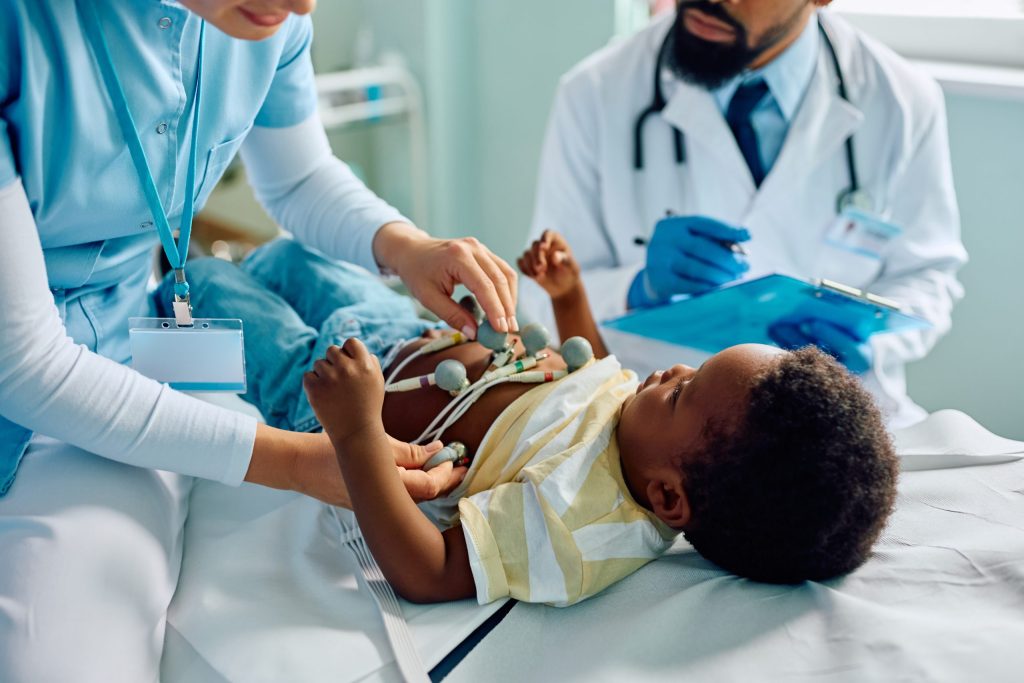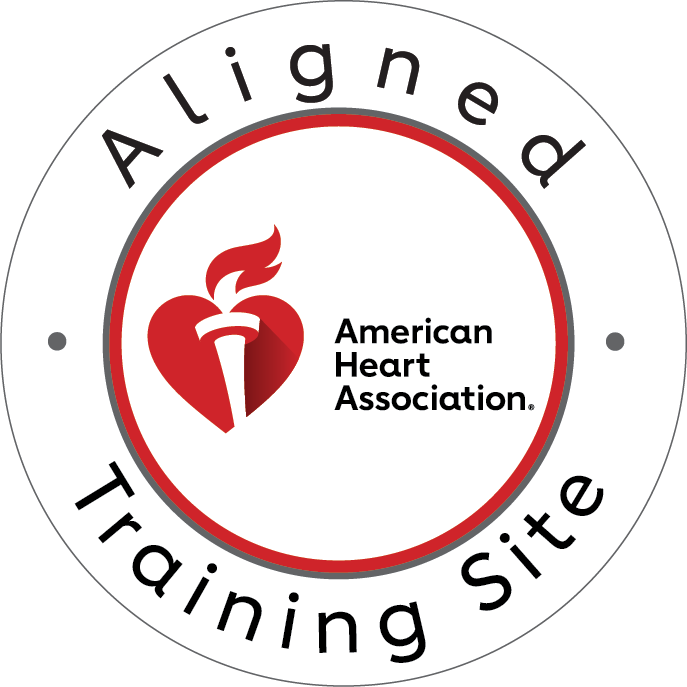I. Introduction
In the high-stakes world of emergency medicine, few scenarios are as challenging and emotionally charged as pediatric cardiac emergencies. Pediatric Advanced Cardiac Life Support (PALS) requires a unique set of skills and knowledge that goes beyond standard adult protocols. Mastering these challenges is crucial for healthcare providers who may encounter critically ill or injured children.
The importance of specialized pediatric resuscitation training cannot be overstated. Children are not simply small adults; their anatomy, physiology, and response to interventions differ significantly from those of adult patients. These differences necessitate a tailored approach to emergency care, one that accounts for the rapid changes in a child’s body from infancy through adolescence.
At CPR Louisville, an American Heart Association (AHA) training site, we understand the critical nature of pediatric-specific training. Our PALS certification course is designed to equip healthcare providers with the skills and confidence needed to manage pediatric emergencies effectively. With a focus on hands-on practice in a stress-free environment, our course ensures that participants are well-prepared for the unique challenges of pediatric resuscitation.
II. Understanding Pediatric Physiology
To effectively manage pediatric emergencies, it’s essential to grasp the key physiological differences between children and adults:
A. Key differences between adult and pediatric patients:
- Respiratory system: Children have smaller airways, and larger tongues relative to oral cavity size, and are predominantly nose breathers in their early years.
- Cardiovascular system: Higher baseline heart rates, lower blood pressure, and smaller blood volumes make children more susceptible to shock.
- Thermoregulation: Infants and young children are more prone to heat loss due to their larger surface area-to-volume ratio.
- Metabolism: Higher metabolic rates affect medication dosing and response to interventions.
B. Age-specific considerations in pediatric resuscitation:
- Infants (0-1 year): Unique CPR techniques, including two-finger chest compressions and back slaps for choking.
- Toddlers and preschoolers (1-5 years): Transition to one-hand chest compressions, increasing awareness of environmental hazards.
- School-age children (5-12 years): More adult-like physiology, but still requiring weight-based medication dosing.
- Adolescents (12+ years): Approaching adult protocols, but with continued attention to developmental differences.
Understanding these fundamental differences is the first step in mastering pediatric ACLS. In the following sections, we’ll delve deeper into the specific components of pediatric resuscitation, including airway management, medication administration, and rhythm recognition.
III. Essential Components of Pediatric ACLS
Mastering pediatric ACLS requires proficiency in several key areas:
A. Recognition of respiratory distress and failure
Early recognition of respiratory problems is crucial in preventing cardiac arrest in children. Signs to watch for include:
- Increased work of breathing (retractions, nasal flaring)
- Abnormal breath sounds (wheezing, grunting)
- Changes in mental status
- Cyanosis or pallor
Healthcare providers must be able to quickly assess these signs and intervene appropriately.
B. Proper airway management techniques
Airway management in children requires special considerations:
- Proper positioning: Slight head tilt-chin lift for infants, neutral position for children
- Appropriate sizing of equipment (e.g., bag-valve masks, oral airways)
- Use of jaw thrust maneuver in suspected cervical spine injuries
- Awareness of anatomical differences that can complicate intubation
C. High-quality CPR for infants and children
Effective chest compressions are vital for successful resuscitation:
- Proper hand placement: Two fingers for infants, one or two hands for children
- Appropriate depth: At least one-third of the anterior-posterior diameter of the chest
- Correct rate: 100-120 compressions per minute
- Allowing full chest recoil between compressions
- Minimizing interruptions in chest compressions
D. Appropriate use of AEDs in pediatric patients
While Automated External Defibrillators (AEDs) are designed primarily for adults, they can be life-saving for children in cardiac arrest:
- Use pediatric pads for children under 8 years old if available
- If pediatric pads are unavailable, adult pads can be used with modified placement
- Ensure the AED is used promptly when indicated, as early defibrillation is key to survival in shockable rhythms
Mastering these essential components forms the foundation of effective pediatric ACLS. At CPR Louisville, our PALS course provides hands-on practice with pediatric-specific equipment and scenarios, ensuring that participants can confidently apply these skills in real-world situations.
IV. Medication Administration in Pediatric Emergencies
Proper medication administration is a critical aspect of pediatric ACLS, requiring careful consideration of dosing, timing, and route of administration.
A. Weight-based dosing calculations
Unlike adults, pediatric medication dosing is primarily based on the child’s weight:
- Accurate weight estimation is crucial (use length-based tapes if actual weight is unknown)
- Familiarity with common dosing calculations is essential
- Pre-calculated charts or cognitive aids can help reduce errors under stress
B. Common medications used in pediatric resuscitation
Key medications in pediatric ACLS include:
- Epinephrine: First-line drug for cardiac arrest
- Amiodarone or Lidocaine: For shock-refractory ventricular fibrillation or pulseless ventricular tachycardia
- Adenosine: For supraventricular tachycardia
- Atropine: For symptomatic bradycardia (less commonly used in current guidelines)
- Naloxone: For opioid overdose
Understanding the indications, dosages, and potential side effects of these medications is crucial for safe and effective administration.
C. Routes of administration specific to children
Various routes of medication administration may be used in pediatric emergencies:
- Intravenous (IV): Preferred route when available
- Intraosseous (IO): Valuable alternative when IV access is challenging
- Intramuscular (IM): Used for certain medications when IV/IO access is unavailable
- Intranasal: Increasingly used for medications like naloxone in pre-hospital settings
- Endotracheal: Less favored but may be used as a last resort for certain drugs
Providers must be proficient in these various administration techniques, particularly in establishing IO access, which can be lifesaving in critically ill children.
At CPR Louisville, our PALS course provides comprehensive training on pediatric medication administration, including hands-on practice with weight-based calculations and simulated emergency scenarios. This ensures that participants are well-prepared to handle the complexities of medication management in pediatric resuscitation.
V. Cardiac Rhythm Recognition and Management
Accurate identification and appropriate management of cardiac rhythms are crucial skills in pediatric ACLS.
A. Identifying pediatric arrhythmias
Key rhythms to recognize in pediatric patients include:
- Asystole
- Pulseless Electrical Activity (PEA)
- Ventricular Fibrillation (VF)
- Pulseless Ventricular Tachycardia (pVT)
- Supraventricular Tachycardia (SVT)
- Bradycardia
It’s important to note that the most common cause of cardiac arrest in children is respiratory failure leading to bradycardia and eventual asystole, rather than the VF/VT more commonly seen in adults.
B. Age-specific treatment algorithms
Treatment approaches vary based on the patient’s age and the specific rhythm:
- For bradycardia: Focus on oxygenation and ventilation before considering medications
- For tachycardias: Distinguish between narrow and wide complex, and assess for hemodynamic stability
- For pulseless arrest: Follow the pediatric cardiac arrest algorithm, emphasizing high-quality CPR
Providers must be familiar with these algorithms and able to implement them quickly and accurately.
C. Proper use of defibrillation and cardioversion in children
When electrical therapy is indicated:
- Use appropriate energy doses: 2-4 J/kg for defibrillation, 0.5-1 J/kg for initial synchronized cardioversion
- Ensure proper pad placement and size
- Minimize interruptions to chest compressions during defibrillator charging
- Be prepared to escalate energy levels for refractory arrhythmias
Understanding the differences between defibrillation (for pulseless VF/VT) and synchronized cardioversion (for persistent, symptomatic tachyarrhythmias with a pulse) is crucial.
At CPR Louisville, our PALS course provides extensive practice in rhythm recognition and management. Through simulated scenarios and hands-on training with pediatric-specific equipment, participants gain confidence in identifying and treating various cardiac rhythms in children.
VI. Team Dynamics in Pediatric Resuscitation
Effective teamwork is crucial in managing pediatric emergencies. The complexity of these situations demands seamless coordination and clear communication among team members.
A. Effective communication strategies
Clear, concise communication is essential in high-stress situations:
- Use closed-loop communication to ensure messages are received and understood
- Employ clear, direct language and avoid ambiguity
- Encourage all team members to speak up if they have concerns or suggestions
- Utilize standardized communication tools like SBAR (Situation, Background, Assessment, Recommendation)
B. Role assignment and leadership in pediatric codes
Clearly defined roles help ensure all necessary tasks are completed efficiently:
- Team leader: Oversees the resuscitation effort and makes key decisions
- Airway manager: Focuses on maintaining and securing the airway
- Compressor(s): Provides high-quality chest compressions
- Medication nurse: Prepares and administers medications
- Recorder: Documents all interventions and timings
The team leader should assign roles based on team members’ skills and experience, and be prepared to reassign as needed.
C. Family presence during resuscitation efforts
The presence of family members during pediatric resuscitation is an important consideration:
- When appropriate, allow family to be present if they wish
- Assign a dedicated team member to support and communicate with the family
- Be prepared to explain procedures and answer questions in lay terms
- Recognize that family presence can provide emotional support for the patient and valuable information to the medical team
At CPR Louisville, our PALS course emphasizes the importance of effective team dynamics. Through role-playing exercises and simulated scenarios, participants practice these crucial teamwork skills in a safe, supportive environment.
VII. Specialized Scenarios in Pediatric ACLS
Certain situations require specific knowledge and skills beyond standard pediatric resuscitation protocols.
A. Drowning and hypothermia
Drowning is a leading cause of accidental death in children:
- Focus on airway management and oxygenation
- Be prepared for associated hypothermia
- Consider delayed neurological sequelae and monitor closely
In hypothermia cases:
- Gentle handling to avoid triggering arrhythmias
- Core temperature monitoring
- Gradual rewarming techniques
- Prolonged resuscitation efforts may be warranted
B. Toxicological emergencies
Pediatric poisonings require specific interventions:
- Rapid identification of the toxin when possible
- Appropriate decontamination measures
- Specific antidotes when applicable (e.g., naloxone for opioids)
- Supportive care and close monitoring for delayed effects
C. Trauma-related cardiac arrest in children
Traumatic arrests in children have poor outcomes but require a modified approach:
- Rapid assessment and treatment of reversible causes (tension pneumothorax, hypovolemia)
- Consider immediate thoracotomy in penetrating chest trauma
- Emphasis on blood product resuscitation rather than crystalloids
- Early activation of massive transfusion protocols when indicated
At CPR Louisville, our PALS course covers these specialized scenarios, providing participants with the knowledge and skills to handle these complex situations. Through case-based learning and simulations, healthcare providers can practice applying PALS principles to these challenging cases.
VIII. Post-Resuscitation Care
Successful resuscitation is just the beginning. Proper post-resuscitation care is crucial for improving long-term outcomes in pediatric patients.
A. Stabilization and monitoring
Immediate post-resuscitation priorities include:
- Ensuring adequate oxygenation and ventilation
- Maintaining hemodynamic stability
- Treating persistent arrhythmias
- Monitoring for and managing electrolyte imbalances
- Initiating neuroprotective strategies, including targeted temperature management when indicated
Continuous monitoring of vital signs, cardiac rhythm, capnography, and neurological status is essential.
B. Transport considerations
When transfer to a higher level of care is necessary:
- Stabilize the patient before transport when possible
- Ensure appropriate equipment and medications for potential deterioration during the transfer
- Maintain the same level of monitoring and care during transport
- Provide clear, comprehensive handoff to the receiving team
C. Family support and communication
The post-resuscitation period can be extremely stressful for families:
- Provide frequent updates on the child’s condition
- Explain ongoing treatments and potential outcomes in clear, understandable terms
- Offer emotional support and resources for coping
- Include the family in decision-making processes when appropriate
At CPR Louisville, our PALS course emphasizes the importance of post-resuscitation care. We guide current best practices and discuss the challenges healthcare providers may face in this critical phase of care.
IX. Hands-on Training at CPR Louisville
A. Overview of PALS certification course
Our PALS course offers:
- Comprehensive coverage of pediatric assessment and basic life support skills
- In-depth review of recognition and management of respiratory and shock emergencies
- Hands-on practice with high-fidelity simulations
- Current AHA guidelines and evidence-based practices
B. Stress-free learning environment
We prioritize creating a supportive atmosphere:
- Small group sizes for individualized attention
- Experienced instructors who understand the challenges of pediatric emergencies
- Opportunity for questions and discussion throughout the course
C. Importance of regular recertification
PALS skills require regular practice and updates:
- Biennial recertification is required to maintain current status
- Frequent review helps maintain confidence and competence in high-stress situations
- Recertification courses provide updates on the latest guidelines and best practices
X. Conclusion
A. Recap of key challenges in pediatric ACLS
Mastering Pediatric Advanced Cardiac Life Support presents unique challenges:
- Understanding the physiological differences between children and adults
- Recognizing and responding to the most common causes of pediatric cardiac arrest
- Implementing age-specific and weight-based interventions
- Managing the emotional complexity of treating critically ill children
These challenges underscore the importance of specialized training and regular skill maintenance in pediatric resuscitation.
B. Emphasis on continuous education and skill maintenance
Proficiency in pediatric ACLS requires ongoing commitment:
- Regular practice of psychomotor skills, such as high-quality CPR and airway management
- Staying updated on the latest guidelines and evidence-based practices
- Participating in simulated scenarios to hone decision-making skills under pressure
- Engaging in debriefings and reflective practice to continuously improve performance
C. Encouragement to enroll in CPR Louisville’s PALS course
At CPR Louisville, we are dedicated to providing the highest quality PALS training:
- Our AHA-certified courses offer the most current, evidence-based content
- Our experienced instructors create a supportive, hands-on learning environment
- We focus on building both competence and confidence in managing pediatric emergencies
We encourage all healthcare providers who may encounter pediatric patients to enroll in our PALS course. Whether you’re seeking initial certification or recertification, our program will equip you with the knowledge and skills needed to provide optimal care in pediatric emergencies.
Remember, in the critical moments of a pediatric cardiac emergency, your skills and confidence can make a life-changing difference. Invest in your abilities, and by extension, in the lives of the children you may one day be called upon to save.
Enroll in CPR Louisville’s PALS course today and take the next step in mastering the unique challenges of pediatric ACLS.





